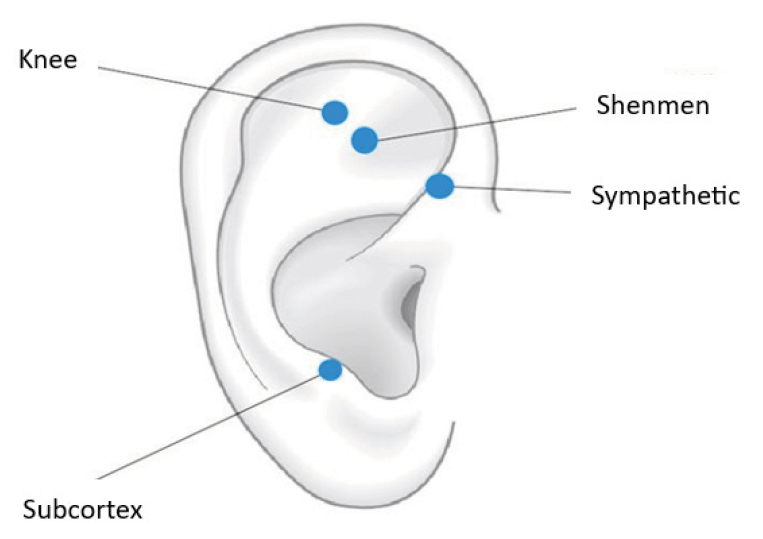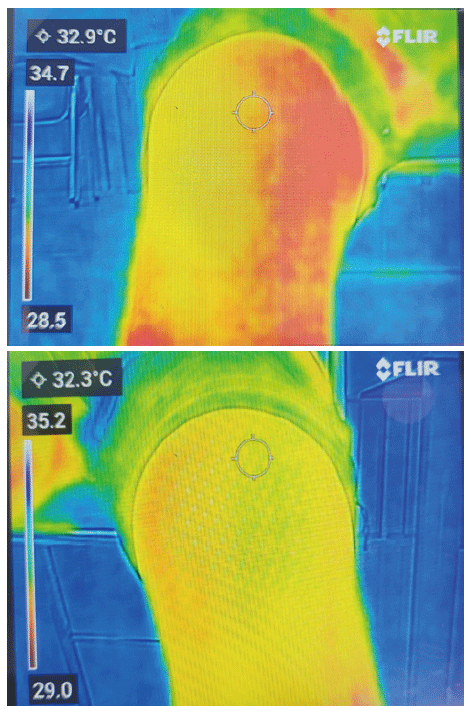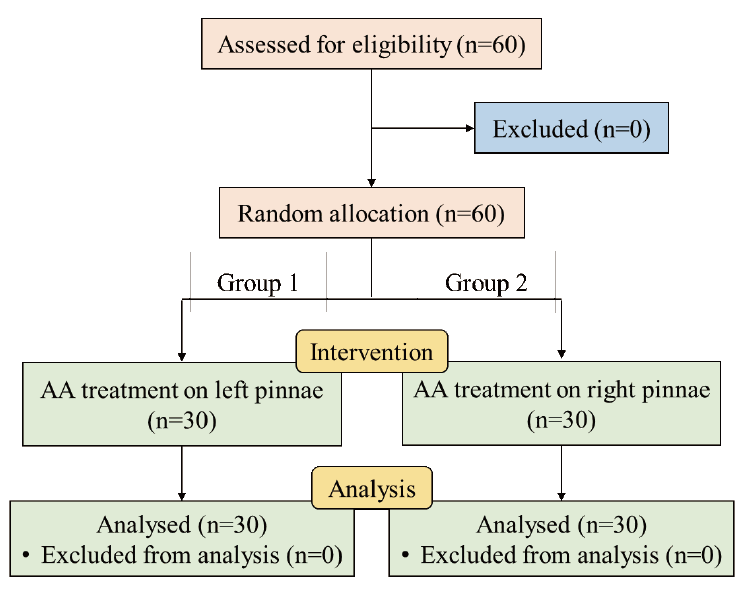1. INTRODUCTION
Ear acupuncture is a micro-system acupuncture technique,employs needles or other devices to stimulate specific points on the pinna for the treatment and prevention of diseases. This technique has a long history, dating back approximately 2,500 years, with minimal side effects [1]. The earliest documented reference comes from the Chinese text Huang Di Nei Jing (The Yellow Emperor’s Classic of Internal Medicine). Ear acupuncture is known for its simple application, extensive applicability in managing pain associated with musculoskeletal diseases [2,3]. For knee osteoarthritis (OA), a randomized controlled trial by Zhang et al. demonstrated that auricular acupressure (AA) at the knee, shenmen, sympathetic, and subcortex points improved VAS score, WOMAC score, and reduced NSAID requirements [4]. However, the precise mechanism underlying this analgesic effect of AA has not been fully understood. Several theo-ries have been proposed including somatotopic arrangement, embryological regions and meridian theory [5]. A significant correlation between alterations in pressure pain thresholds and local perfusion has been reported during filiform needle acupuncture at the acu-point LI4 [6]. This raises a compelling question of whether the analgesic impact of AA in knee OA may be linked to shifts in the local microcirculation flux in the knee joint area. Therefore, this study investigated the change in microcirculation, as indicated by the skin temperature of the knee joint in healthy volunteers, following the application of AA at the knee, shenmen, sympathetic, subcortex points. The aim was to gain a better understanding of this analgesic effect of AA in the treatment of knee OA.
2. MATERIALS AND METHODS
This before-after interventional pilot study was conducted on 60 healthy volunteers between January 2023 and April 2023. The study adhered to the Consolidated Standards of Reporting Trials (CONSORT) and Standards for Reporting Interventions in Clinical Trials of Acupuncture (STRICTA) guidelines [7].
This trial included two groups, each consisting of 30 participants, the group composition determined using the following formula:
In which, α=0,05 and β=0.1 so C=10.51, r=0.7 and ES=0.46 [8]
Eligible participants for the study met the following criteria: (1) healthy adults aged from 18 to 30 years old with a body mass index (BMI) between 18.6–22.9 kg/m2 and vital signs within normal ranges, (2) providing voluntary agreement to participate in the study, (3) feeling mentally and physically comfortable during the study period (assessed using the DASS scale with a stress score of less than 15 points), (4) without impaired thermoregulation and (5) not having received any knee area treatments such as acupuncture, cupping, cataplasm, or massage within one day prior to the study. Participants who met any of the following criteria were excluded from this study: 1) auricular infections or inflammation, 2) consumption of alcoholic drinks, coffee, or tobacco within 24 hours, 3) vigorous exercise within 2 hours preceding, 4) use of vasodilators, 5) needle phobia [8,9].
Participants were randomly assigned to either Group 1 or Group 2 through a lottery system with a 1:1 ratio. Prior to the intervention, all participants underwent a 10-minute familiarization period to stabilize their physiological parameters such as breathing rate, blood pressure, and heart rate and to stop sweating. In Group 1, participants received AA treatment at the knee, shenmen, sympathetic, sub-cortex points on the left pinna, using Vaccaria ear seeds (diameter 2 mm, Huanqiu, Beijing, China). The anatomic location of these four points are illustrated in Fig. 1. The ear seeds were affixed to the skin with tan-colored adhesive tape and pressed continuously for three minutes to elicit the deqi sensation. They were then withdrawn once the measurement of the skin temperature was completed. The procedures in Group 2 were similar to those in the AA group, with the exception that the AA was applied on the right pinna. The inter-vention was administered by the principal investigators, both experienced traditional medicine with 5 years of expertise AA treatment.

Skin temperature in the knee joints on both sides (℃) was measured at baseline and 30 minutes post-intervention using FLIR C5 Compact Thermal Camera (FLIR, Wilsonville, OR, USA). This device was made in Estonia with technical specifications as followed (1) infrared sensor 160×120 (19,200 pixels), (2) object temperature range from –20℃ to +400℃, (3) thermal sensitivity <70 mK (<0.05℃), and (4) accuracy ±3%.
Additionally, any adverse events experienced during the study, such as pain at insertion site, local discomfort, dizziness, nausea were documented.
Data processing was conducted using Epidata 3.1, with subsequent analyzis carried out using SPSS 20 (IBM, Chicago, IL, USA). Quantitative variables were presented as mean±SD due to normal distribution, qualitative variables were presented as frequencies. Baseline characteristics between the two groups were compared using t-test for means and the cho-square test for proportions. Within each group, paired t-test was employed to compare the skin temperature measured at baseline with those who measured 30 minutes post- intervention. The mean difference in skin temperature changes from baseline to 30 minutes after the intervention between the two knee joints in each group was compared using t-test. Statistically significant was considered at p<0.05.
3. RESULTS
All 60 participants underwent eligibility screening, and none were excluded or withdrew from the study (Fig. 2). Baseline charateris-tics including gender, age, and BMI did not show significant differences between the two groups (p>0.05) (Table 1).
|
Group 1 (n=30) |
Group 2 (n=30) |
p-value1) |
|
|---|---|---|---|
|
Male/female |
12/18 |
16/14 |
0.825 |
|
Age (mean±SD) |
22.57±1.76 |
23.13±1.22 |
0.152 |
|
BMI (mean±SD) |
20.80±1.82 |
20.80±1.50 |
0.934 |
There was no significant difference observed between the two knee joints in the skin temperature at baseline as well as after AA at the knee, shenmen, sympathetic, and subcortex points on the left pinna (p>0.05). Although there was an increase in the skin tempera-ture of both knee joints after AA, this difference did not statistical significant compared to the baseline measurement (p>0.05) (Table 2).
|
Left knee joint skin surface temperature (℃) |
Right knee joint skin surface temperature (℃) |
p-value1) |
|
|---|---|---|---|
|
Baseline |
33.07±1.07 |
33.12±1.09 |
0.141 |
|
After AA |
33.22±1.14 |
33.31±1.16 |
0.247 |
|
p-value2) |
0.362 |
0.524 |
No significant difference was found between the two knee joints in the skin temperature at baseline as well as after AA at the knee, shenmen, sympathetic, and subcortex points on the right pinna (p>0.05). After AA, the skin temperature of both knee joints increased significantly compared with one measured at baseline (p<0.05) (Table 3, Fig. 3).

|
Left knee joint skin surface temperature (℃) |
Right knee joint skin surface temperature (℃) |
p-value1) |
|
|---|---|---|---|
|
Baseline |
32.68±1.45 |
33.20±1.06 |
0.501 |
|
After AA |
33.17±1.39 |
33.62±1.33 |
0.109 |
|
p-value2) |
0.010 |
0.017 |
4. DISCUSSION
There were no significant differences in terms of age, gender and BMI between the two groups involved in this trial. Since these fac-tors are known to impact skin temperature [10], the even distribution within the two groups assisted in reducing the potential confound-ing effects.
This study demonstrated that AA at the knee, shenmen, sympathetic, and subcortex points on each side led to an increase in the skin temperature in both knees. However, the increase in skin temperature was not statistically significant after AA on the left pinna. Notably, Xu et al. conducted a trial on 32 patients with cervical spondylosis and reported a significant rise in skin temperature at the C3 cervical vertebrae region following AA at the Neck point [11]. Gagliardi et al. also similarly demonstrated that low-frequency au-ricular stimulation at the shenmen and Thalamus points increased the cutaneous microcirculatory flux, without significantly modifying blood pressure and heart rate [12]. However, our findings contrast with those of Huynh et al, who observed that AA at the tooth point on each side significantly increased the skin temperature of the ipsilateral mandibular area. FLIR C5 Compact Thermal Camera was used to measure the temperature in this trial as well [8]. Given the similarity between the sample characteristics in our study and those in Huynh et al, the divergence in findings could be attributed to the choice of points. Besides the knee point, which corresponds to the region in a manner similar to Huynh et al., the selection of the other three points was based on their respective functions, as well as considerations of the pathology and physiology associated with knee OA.
The mechanism underlying the effect of AA on the skin temperature at the knee joints may involve the parasympathetic nervous system since stimulation of the vagus nerve leads to vasodilation and increases microcirculation flux [13]. Previous research has sug-gested that AA performed at the shenmen point or at the sympathetic point can enhance the parasympathetic nerve activities manifest-ed by changes in heart rate variability [14,15]. This effect is thought to occur via the auriculovagal afferent pathway. The auricular concha and the region surrounding the auditory meatus are primarily innerved by the auricular branch of the vagus nerve (ABVN), which represents the sole peripheral branch of the tenth cranial nerve. ABVN terminates in the brainstem’s nucleus of the solitary tract (NTS). The NTS acts as a relay center for visceral primary afferent signals from different organs and regions. Neuronal processing of theses signals within the NTS contributes to autonomic reflexes governing autonomic function [5].
Given the potential association between AA and skin temperature changes at the knee through the parasympathetic nervous system, the disparity noted in AA effects between the two ears may stem from the hemisphere asymmetry in regulating parasympathetic out-flow. Specifically, parasympathetic activity is predominantly governed by the left hemisphere of the cerebrum [16]. Therefore, AA performed in the right pinna may induce a more effective stimulation of the parasympathetic nervous system compared to the opposite side. In addition, the increase in the skin temperature at the knee joints following AA could be appertaining to the release of nitric oxide (NO) as AA has been reported to induce a slight elevation in the serum NO level [17]. This molecular messenger stimulates the transformation of cyclic guanosine triphosphate into cyclic guanosine monophosphate within vascular smooth muscle cells, resulting in vasodilation. This, in turn, augments blood circulation to the skin’s surface, leading to an elevation in skin temperature [18].
Our findings suggest that the effect of AA performed at the knee, shenmen, sympathetic, and subcortex points on microcirculation might be one of the mechanisms for pain management in patients with knee OA. Further research is needed to achieve a better knowledge of the mechanisms of AA in the treatment of knee OA.
For AA, the most frequently reported adverse events were local skin irritation and discomfort, mild tenderness or pain, and dizziness. The majority of these occurrences were transient, mild, and tolerable, and no serious adverse events were identified [19]. In this study, no adverse events from AA were observed during AA at the knee, shenmen, sympathetic, and subcortex points on each side. This aligns with previous research by Trinh et al which also reported no adverse reactions during acupressure at the left sympathetic acu-point [15], when performing acupressure at the shenmen point on the pinna [14]. These findings suggest that AA is generally safe and well-tolerated, with potential benefits outweighing any associated risks.
5. CONCLUSION
The observed increase in skin temperature at knee joint following AA at the knee, shenmen, sympathetic, and subcortex points pro-vides valuable insight into analgesic effect of AA in management of knee OA. However, further research is needed to clarify the un-derlying mechanism driving this phenomenon.

